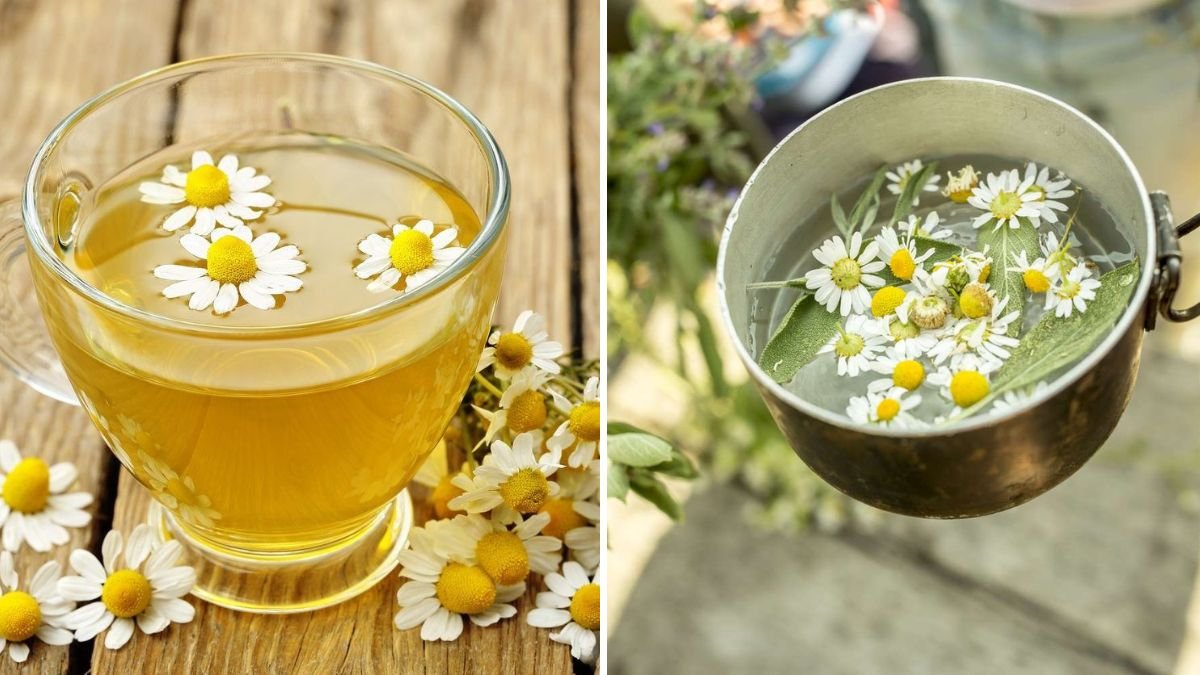Chamomile is one of nature’s most versatile herbs, prized for its gentle fragrance, calming properties, and beneficial effects in both culinary and gardening applications. Its daisy-like blooms and feathery foliage add charm to any space, while its aromatic properties enhance teas, meals, and garden health. Whether you’re a seasoned gardener, a home cook, or a DIY enthusiast, chamomile offers countless creative uses beyond the ordinary cup of tea.
This guide explores five unique ways to use chamomile in your kitchen and garden, with detailed instructions, tips, and benefits to help you make the most of this wonderful herb.
1. Chamomile Tea: A Calming Culinary Classic
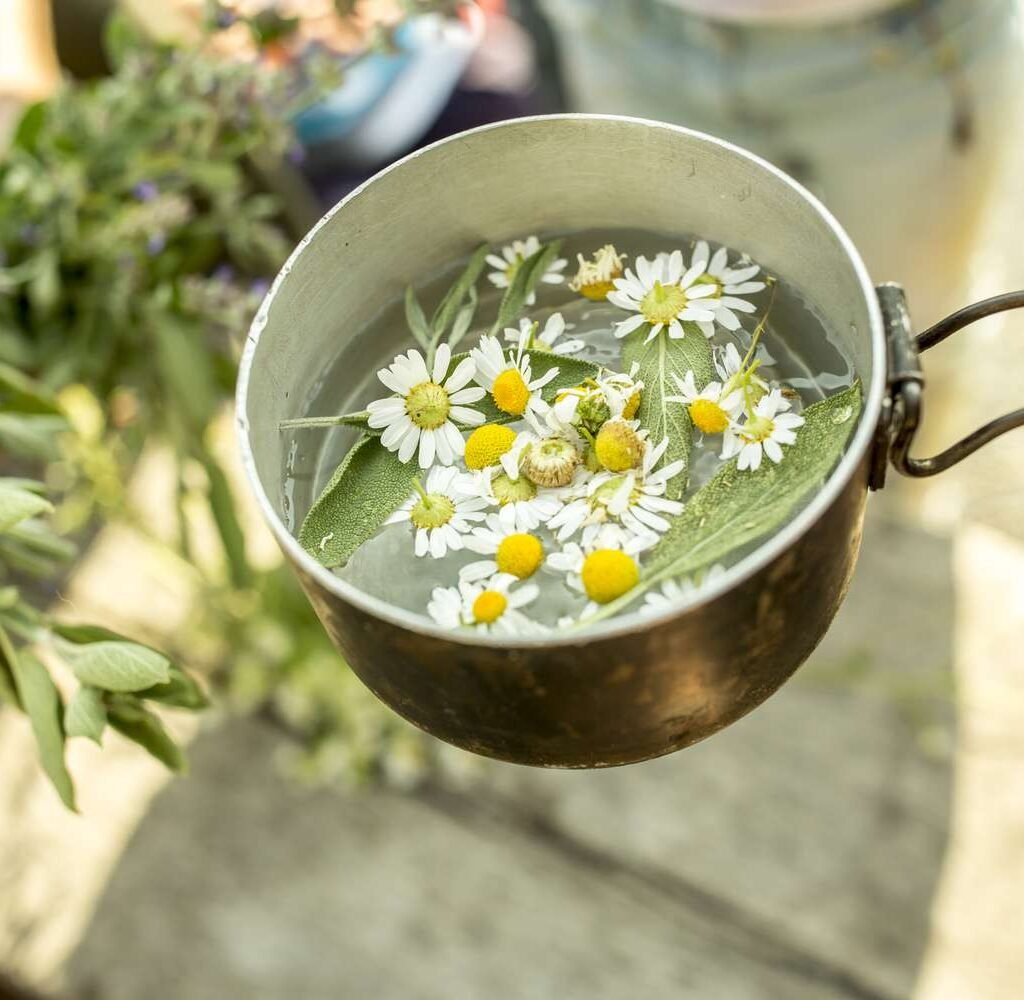
The most familiar use of chamomile is as a soothing herbal tea, renowned for its relaxing properties. But chamomile tea can also be a versatile ingredient in culinary creations.
How to Prepare Chamomile Tea:
- Harvest Fresh Flowers: Use pesticide-free chamomile blooms.
- Dry the Petals: Spread them on a tray in a cool, dark area for 2–3 days.
- Brew the Tea: Add 1–2 teaspoons of dried flowers to a cup of hot water. Steep for 5–7 minutes.
- Enhance Flavor: Add honey, lemon, or a cinnamon stick for extra warmth.
Culinary Uses Beyond Tea:
- Chamomile Syrup: Simmer chamomile flowers with sugar and water to create a fragrant syrup for desserts or cocktails.
- Infused Milk or Cream: Add chamomile to cream for custards, panna cotta, or ice cream.
- Baking: Mix dried chamomile into cookies, scones, or muffins for subtle floral notes.
Benefits:
- Provides calming, stress-relieving effects.
- Offers mild anti-inflammatory and digestive benefits.
- Adds delicate, natural flavor to culinary creations.
Tip: For a more intense flavor, combine chamomile with other herbs like mint, lavender, or lemon balm.
2. Chamomile as a Companion Plant in the Garden
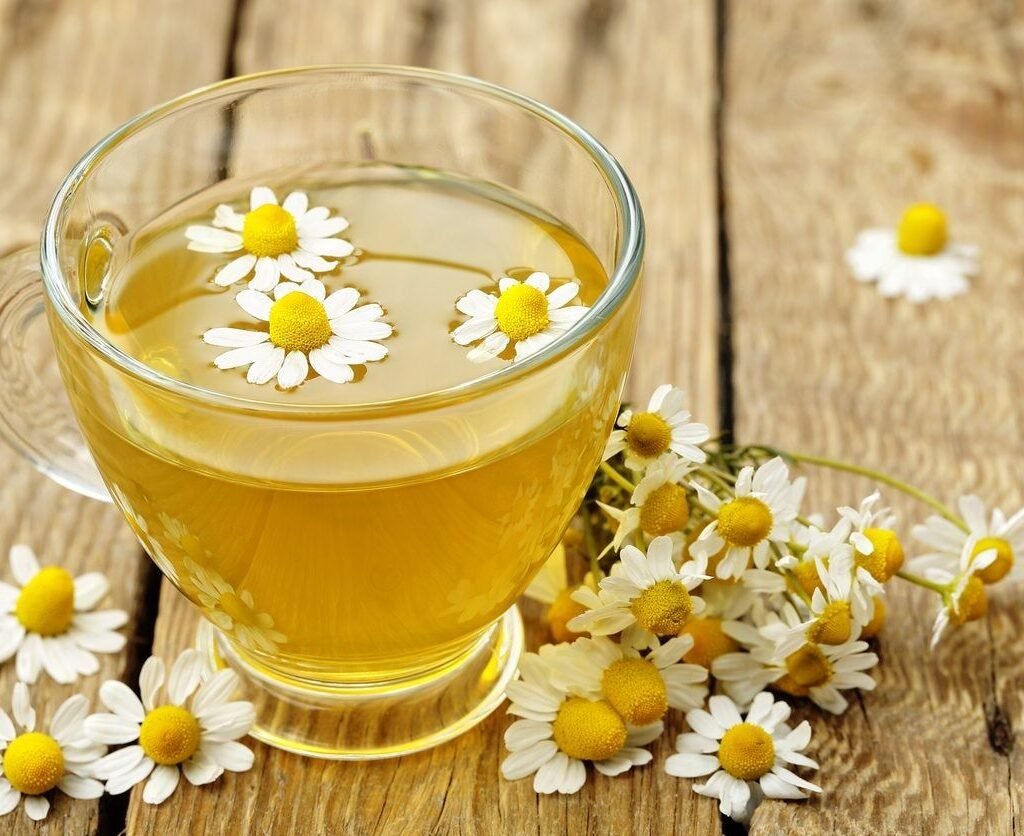
Chamomile is not just for the kitchen—it’s a powerful ally in the garden. Its presence can enhance the health of nearby plants and attract beneficial insects.
Ways to Use Chamomile in Your Garden:
- Companion Planting: Chamomile improves the growth and flavor of vegetables like cabbage, onions, and tomatoes. Its natural compounds can strengthen plant immunity.
- Pollinator Magnet: Bees and hoverflies are attracted to chamomile flowers, increasing pollination for fruiting plants.
- Soil Health Enhancer: Chamomile attracts predatory insects that eat pests, reducing the need for chemical pesticides.
Planting Tips:
- Plant chamomile near vegetable beds or herb gardens.
- Choose a sunny location with well-drained soil.
- Harvest flowers regularly to encourage continuous blooms.
Benefits:
- Improves plant health naturally without chemicals.
- Encourages a thriving, biodiverse garden ecosystem.
- Adds beauty and fragrance to garden beds while supporting beneficial insects.
Tip: Use chamomile as a border plant around vegetable beds for both aesthetics and practical benefits.
3. Chamomile-Infused Oil and Butter for Cooking and Skincare
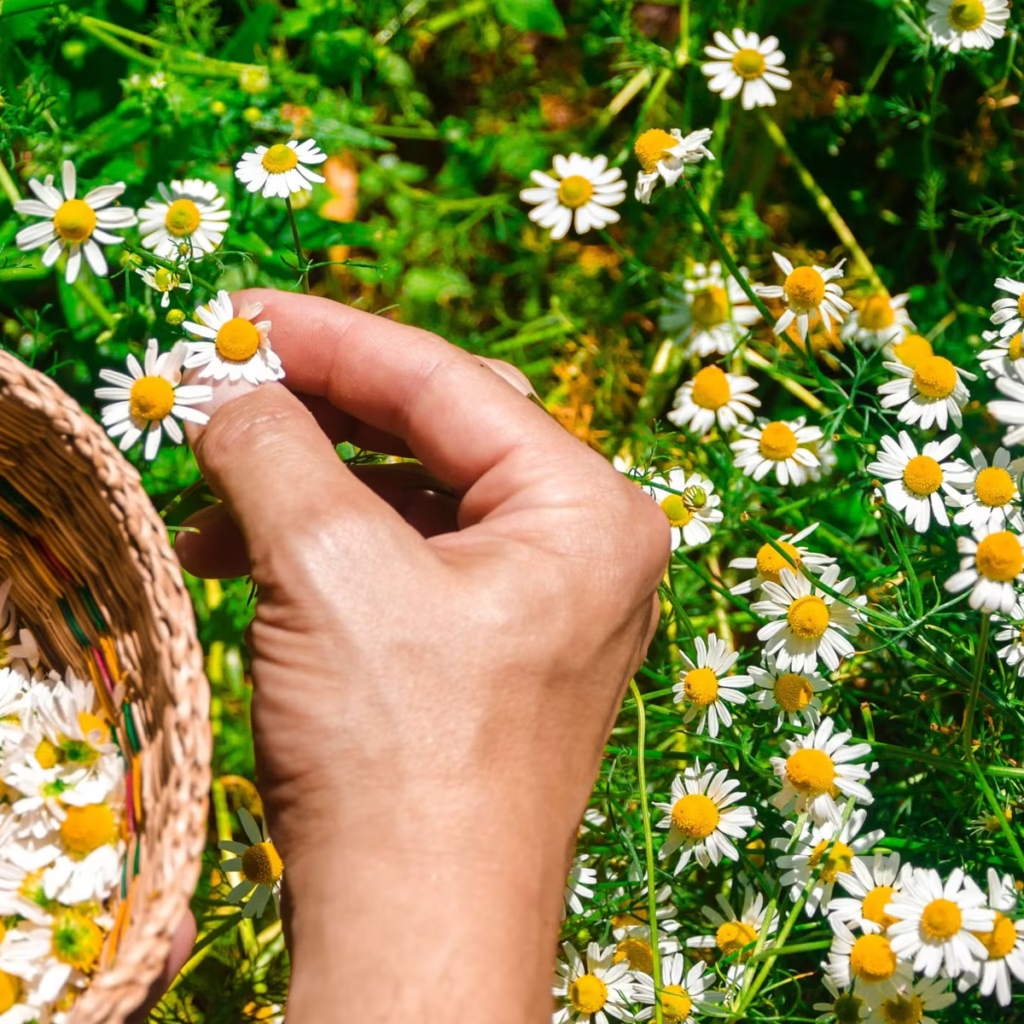
Chamomile’s delicate scent and therapeutic properties make it ideal for infused oils and butters, which can be used in both culinary and skincare applications.
Chamomile-Infused Oil:
- Combine Fresh or Dried Flowers with a neutral oil like olive, sunflower, or almond oil.
- Heat Gently: Use a double boiler for 2–3 hours, ensuring oil does not boil.
- Strain and Store: Store in a dark glass bottle in a cool, dry place.
Uses:
- Cooking: Drizzle over salads, roast vegetables, or baked goods for a subtle floral note.
- Skincare: Use as a massage oil, cuticle oil, or moisturizer for calming, anti-inflammatory effects.
Chamomile-Infused Butter:
- Melt unsalted butter and steep chamomile flowers for 10–15 minutes.
- Strain and refrigerate for use in baking, cooking, or spreading on bread.
Benefits:
- Adds gentle floral flavor and aroma to recipes.
- Offers skin-soothing properties when used topically.
- Preserves chamomile’s delicate aroma for extended use.
Tip: Always use pesticide-free chamomile, especially if using for food or skincare.
4. Chamomile Water for Hair and Skin
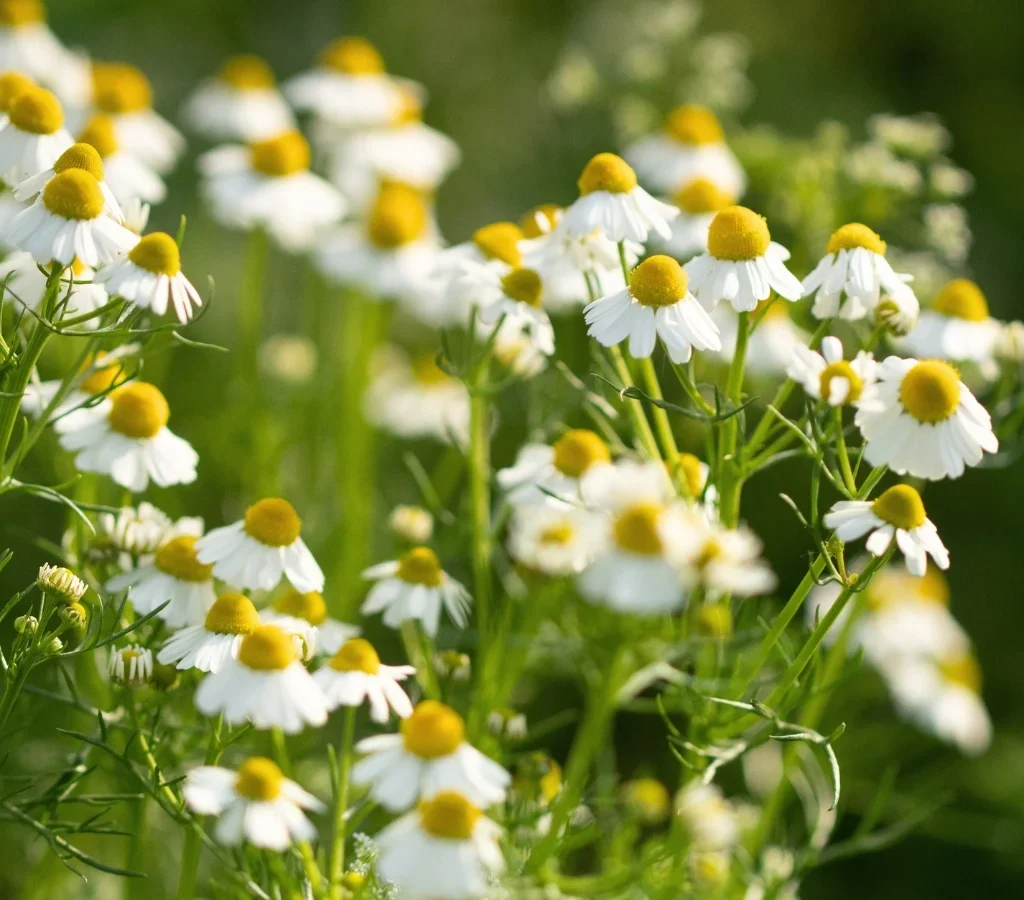
Chamomile’s natural anti-inflammatory and brightening properties make it a versatile ingredient for homemade hair and skincare treatments.
Chamomile Hair Rinse:
- Brew a strong chamomile tea using fresh or dried flowers.
- Cool the tea and pour over clean, damp hair as a final rinse.
- Gently massage into the scalp and leave for 10–15 minutes before rinsing lightly.
Benefits for Hair:
- Enhances blonde highlights naturally.
- Soothes an itchy or irritated scalp.
- Adds shine and softness to hair strands.
Chamomile Facial Toner:
- Brew chamomile tea and allow it to cool completely.
- Pour into a spray bottle or use a cotton pad to apply to the skin.
- Store remaining liquid in the refrigerator for up to a week.
Benefits for Skin:
- Reduces redness and inflammation.
- Calms sensitive or irritated skin.
- Provides antioxidant support for a healthy glow.
Tip: Combine chamomile with other soothing herbs like calendula or lavender for enhanced skin benefits.
5. Chamomile Potpourri and Natural Air Freshener
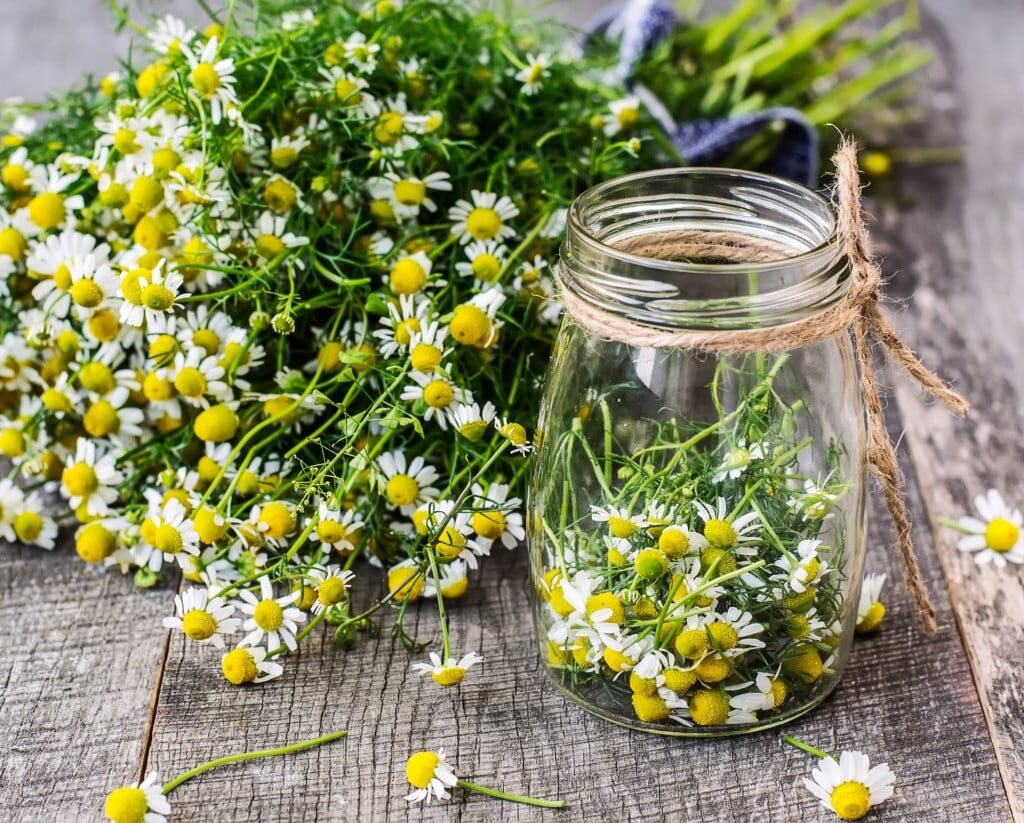
Chamomile’s sweet, apple-like fragrance makes it a wonderful addition to potpourri and natural air fresheners, creating a soothing atmosphere indoors.
How to Make Chamomile Potpourri:
- Dry chamomile flowers thoroughly.
- Mix with other dried flowers, herbs, or spices like lavender, rose petals, cinnamon sticks, and cloves.
- Store in decorative bowls, sachets, or small jars around the home.
Chamomile Air Freshener Spray:
- Brew a strong chamomile tea and add a few drops of essential oils like lemon, orange, or lavender.
- Pour into a spray bottle and mist rooms, linens, or curtains.
Benefits:
- Naturally fragrances your home without synthetic chemicals.
- Provides a calming, relaxing aroma for bedrooms, living rooms, or bathrooms.
- Adds a decorative touch through colorful, fragrant dried flowers.
Tip: Refresh potpourri every few weeks by lightly crushing flowers or adding a few drops of essential oil.
Additional Tips for Using Chamomile Effectively
- Harvest Strategically: Pick flowers in the morning when they are fully open and fragrant.
- Use Pesticide-Free Plants: Essential for edible, hair, or skin applications.
- Dry Properly: Use a cool, ventilated area to preserve aroma, color, and potency.
- Combine with Other Herbs: Pair chamomile with mint, lavender, or calendula for complementary effects.
- Rotate Uses: Harvest some flowers for culinary use, some for garden planting, and some for décor or DIY projects to maximize versatility.
Benefits of Using Chamomile in Kitchen and Garden
- Versatile Culinary Herb: Enhances teas, baked goods, syrups, and infusions.
- Natural Garden Ally: Improves soil health, supports beneficial insects, and protects companion plants.
- Skincare and Haircare: Calms irritation, brightens skin, and adds shine to hair naturally.
- Aromatherapy and Home Décor: Provides calming, fragrant solutions for the home.
- Cost-Effective: One plant can provide flowers for multiple uses, making it economical and sustainable.
Chamomile’s multifaceted uses make it a must-have for home gardeners, cooks, and DIY enthusiasts alike. Its gentle aroma, subtle flavors, and plant health benefits make it an indispensable tool in your garden and kitchen arsenal.
Conclusion
Chamomile is much more than a simple tea herb—it is a multi-purpose plant that can transform your kitchen, garden, and home environment. By exploring these five unique uses, you can enjoy chamomile in ways that go beyond tradition: brewing calming teas, enhancing culinary creations, infusing oils and butters, rejuvenating hair and skin, and creating fragrant home décor.
Whether planted as a garden companion, used in culinary adventures, or incorporated into DIY wellness and décor projects, chamomile offers endless possibilities. Its delicate flowers, soothing aroma, and beneficial properties make it a versatile, sustainable, and beautiful addition to any home.
By cultivating and utilizing chamomile creatively, you maximize the value of your harvest, enjoy natural beauty and health benefits, and elevate everyday experiences with the gentle power of this extraordinary herb.
